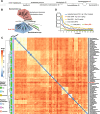A nontuberculous mycobacterium could solve the mystery of the lady from the Franciscan church in Basel, Switzerland
- PMID: 36747166
- PMCID: PMC9903526
- DOI: 10.1186/s12915-022-01509-7
A nontuberculous mycobacterium could solve the mystery of the lady from the Franciscan church in Basel, Switzerland
Abstract
Background: In 1975, the mummified body of a female has been found in the Franciscan church in Basel, Switzerland. Molecular and genealogic analyses unveiled her identity as Anna Catharina Bischoff (ACB), a member of the upper class of post-reformed Basel, who died at the age of 68 years, in 1787. The reason behind her death is still a mystery, especially that toxicological analyses revealed high levels of mercury, a common treatment against infections at that time, in different body organs. The computed tomography (CT) and histological analysis showed bone lesions in the femurs, the rib cage, and the skull, which refers to a potential syphilis case.
Results: Although we could not detect any molecular signs of the syphilis-causing pathogen Treponema pallidum subsp. pallidum, we realized high prevalence of a nontuberculous mycobacterium (NTM) species in brain tissue sample. The genome analysis of this NTM displayed richness of virulence genes and toxins, and similarity to other infectious NTM, known to infect immunocompromised patients. In addition, it displayed potential resistance to mercury compounds, which might indicate a selective advantage against the applied treatment. This suggests that ACB might have suffered from an atypical mycobacteriosis during her life, which could explain the mummy's bone lesion and high mercury concentrations.
Conclusions: The study of this mummy exemplifies the importance of employing differential diagnostic approaches in paleopathological analysis, by combining classical anthropological, radiological, histological, and toxicological observations with molecular analysis. It represents a proof-of-concept for the discovery of not-yet-described ancient pathogens in well-preserved specimens, using de novo metagenomic assembly.
Keywords: Ancient DNA (aDNA); Anna Catharina Bischoff (ACB); Bacteriophage; Brain infections; De novo assembly; Franciscan church mummy; Mycobacteriosis; Nontuberculous mycobacteria (NTM); Syphilis.
© 2023. The Author(s).
Conflict of interest statement
The authors declare no competing interests.
Figures




References
-
- Hotz G, Augsburger M, Briellmann T, Bircher A, Castella V, Fiechter R, et al. Der rätselhafte Mumienfund aus der Barfüsserkirche in Basel. Ein aussergewöhnliches Beispiel interdisziplinärer Familienforschung. Jahrbuch der Schweizerischen Gesellschaft für Familienforschung. 2018;2018:1–30.
-
- Hotz G, Opitz-Belakhal C. Anna Catharina Bischoff. Die Mumie aus der Barfüsserkirche. Basel: Christoph Merian Verlag; 2021.
-
- Wurst C, Maixner F, Castella V, Cipollini G, Hotz G, Zink A. The lady from Basel’s Barfusserkirche - molecular confirmation of the mummy’s identity through mitochondrial DNA of living relatives spanning 22 generations. Forensic Sci Int Genet. 2022;56:102604. doi: 10.1016/j.fsigen.2021.102604. - DOI - PubMed
-
- Briellmann T, Hotz G, Augsburger M, Lenglet S. Toxikologische Untersuchungen. In: Hotz G, Opitz-Belakhal C, editors. Anna Catharina Bischoff die Mumie aus der Barfüsserkirche (Rekonstruktion einer Basler Frauenbiografie des 18 Jahrhunderts) Basel: Christoph Merian Verlag; 2021.
Publication types
MeSH terms
LinkOut - more resources
Full Text Sources
Medical

